Tree Care Tips
- Planting
- Pruning
- Watering
- Fertilizing
- Mulching

How You Pick and Plant Trees Makes All The Difference
It is true that the life force in any plant strives to survive and flourish, but with the cost of today's landscape materials and the long-
term investment landscape trees represent, doing it right up front makes sense.
Bigger is not always better;
A perfect tree is hard to find.
You probably won't, so you're better off not trying. What's important in picking your tree is finding one that will be able to take off fast in your landscape and grow naturally where you plant it. Probably the most important factor in tree selection is having good top and root balance. If there are not enough roots to support the top, you'll either be faced with severe pruning to bring the top into balance, or have a tree that struggles (or fails) during the initial establishment.
Whether the trees at the nursery are balled and or in containers, pick one that is mid-sized. The smallest may be stunted for unseen reasons and might never grow properly. The largest will probably look great in the nursery, but if the top and root size are way out of balance, the smaller, mid-sized tree will leave it eating its dust once planted.
7 Steps to Planting Right
Here's a condensed version of some of the most important factors to consider when tree planting.
- Select a location suitable to the eventual mature size of the tree being planted.
- Create a root establishment transition zone by combining the natural soil of your property with soil high in organic material.
- The planting hole should be twice the diameter of the planting ball. This zone will allow for quicker establishment and better tree stability.
- Don't add fertilizer to the planting mix as this may cause root burn (small amounts of specially formulated very slow release fertilizers are O.K.).
- Stake a new tree only if necessary, and then only for as long as necessary.
- Keep the top of the soil ball slightly above the planting hole in heavy or clay soils and even with the surrounding soil in loose or sandy soils. Build two 4-5'' dikes of soil to direct and contain water. Build one a little smaller than the root ball and the other about 30'' in diameter.
- Water the planting ball every 1 to 3 days for the first 3 or 4 weeks until the roots have moved into the transition zone.
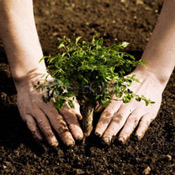 Extra Pointers
Extra Pointers
Always plant trees where they have enough space to
grow naturally to their mature size.
When selecting a tree, the average or mid-sized of a group will usually do best after planting. Mix your soil with organic matter to create a transition zone for fast root development. Water every 1 to 3 days for the first 3 to 4 weeks to keep the root ball moist.
Pruning Keeps Your Landscape A Cut Above
Pruning can make the difference between a landscape that jumps out at you and one that's just so-so. Its true that a strikingly beautiful landscape is the result of a lot of details, but don't cut the importance of pruning short when figuring your grounds care schedule.
When Do Trees Need Pruning?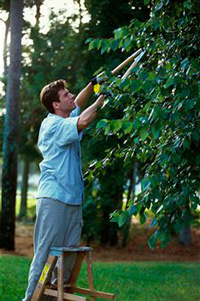
At planting time, pruning compensates for the root loss of transplanting and reduces the demands for water placed on the establishing root system. Another pruning job is the removal of dead wood and crossed branches, and should be done regularly. Branches often grow that are out of balance or asymmetrical to the general shape of the tree. Pruning these out when they're young saves a much bigger pruning job later.
Pruning can also open a tree for better light penetration and air movement, or to make it possible to walk underneath without brushing the lower branches. Thinning (or opening up) a dense tree can sometimes make the difference between being able to grow a lawn beneath it or not. Pruning also helps maintain a balance between new shoot growth and flowering, and in older trees, heavy pruning can often give them a whole new lease on life.
There is one common problem that even expert pruning can't fix. A tree planted where it doesn't belong eventually outgrows its space. No tree should ever be planted closer to a building, walk or drive than 1/2 of its mature spread. When they are, they eventually have to be severely pruned or removed to maintain proper clearance.
Assuming a tree has been planted where its natural growth habit will enhance the landscape it still needs regular careful pruning to maintain good health, shape, and over-all beauty.
Science, art or both?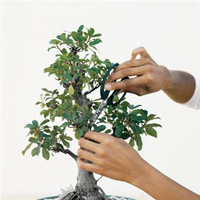
Proper pruning results in trees that are well branched, balanced, and healthy. But there are lots of ways to mess it up. Pruning requires an eye for what a tree should look like, and the knowledge to achieve
that potential with pruning. It really is a combination of art and science.
There is really too much to say about proper pruning for a complete discussion here. But what we hope is that you'll spend a little time before tree pruning to understand what the results should look like;
Be sure to have the proper tools for the job and understand the proper pruning cuts to make.
Extra Pointers
Proper tree pruning should be a regular cultural practice like feeding or pest management. Needed pruning that is neglected leads to serious health and beauty problems and more expensive solutions later. Be sure to understand the pruning process before beginning and to have the proper tools for the job.
Your trees are simply your largest and most irreplaceable landscape investment, and we want you to always make the most of them. And of course, if you ever have any questions, give Dayton Landscaping a call at (937) 299-9794.
Water... Nothing lives without it.
Your trees are no exception. Because larger trees show stress symptoms slowly, a lot of homeowners completely overlook the water needs of the most valuable landscape investment they own. Getting beyond just survival for attractive and healthy growth trees need enough water, and at the right times. Your trees pull water from the soil and lose most of it through tiny pores in the leaves by evaporation (or transpiration).
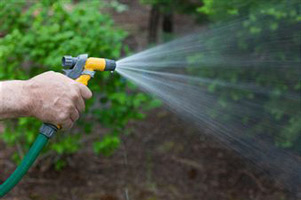
Since most tree roots are located in the top 3 feet of the soil, they can (and do) suffer during periods of extended drought. Deeper roots can supply some of the plants water needs during dry spells. Water stress is still a major concern with both recent transplants and established trees.
Starting them right:
Watering recently planted trees
Most garden centers water their trees a lot, even daily to keep them looking their best for customers. So you should always consider the shock a new environment has on the trees system and help it along with plenty of water until its roots get firmly established.
If you planted the new tree right, there is a transition zone of loose soil between the planting ball and the native soil of your property.
At first, you need to provide extra water to the ball, while also keeping plenty of water in the transition soil. To do this, build two shallow dikes or ridges 4 to 5'' high around the base of the tree: one slightly smaller than the root ball and the other about 30'' in diameter.
For the first 2 to 3 weeks, water the inner circle every 1 to 3 days to assure the root ball has enough moisture. After the roots have penetrated the transition zone (4 to 6 weeks), you can knock down the inner dike. During this early phase, the outer ring will need less water, but do keep it moist.
Watering Established Trees
Established trees do show water stress more slowly, but signs include wilting, change in leaf color and premature leaf drop.
The most important goal is to get as much of the water as possible to the roots of the tree. To accomplish this: eliminate runoff (don't apply water faster than the soil can absorb it), keep the water inside the dripline of the tree, and apply the water evenly across the whole area. Whether old plantings or new, when you give your trees the water they need they give you beauty and growth in return.
Extra Pointers
- The water needs of trees are often overlooked because they show
signs of stressvery slowly. - Garden centers tend to water heavily.
- Water new transplants heavily until the tree adapts to its new environment.
- A double dike system around new plantings will help get water where its
neededduring establishment. - Older trees need water too.
- Watch for signs of stress and provide the water needed to keep them
healthy through drought periods.
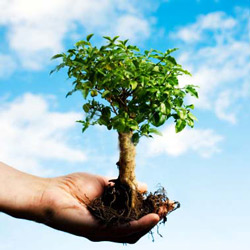 Fertilizing: An Investment That Pays Off
Fertilizing: An Investment That Pays Off
All living things need nourishment and trees and shrubs have a big appetite.
Its true that large, well-established and healthy trees may not need much supplemental feeding, but smaller trees and shrubs will pay you big dividends in return for your feeding investment during their first several years on your property. Your payback will include better disease and insect resistance, improved flowering, and much quicker establishment than similar plants denied regular fertilization.
Plants Need A Balanced Diet
The primary nutrients: Nitrogen (N), Phosphorus (P) and Potassium (K) are all used by your trees in different ways. Nitrogen encourages fast trunk and branch growth, and the production of healthy and dark green leaves. Phosphorus stimulates vigorous root growth (which makes it especially beneficial to recently planted trees and shrubs). Phosphorus also promotes flower bud formation and increases resistance to cold. And potassium makes the trees stronger, helping them to withstand wind and ice breakage as well as diseases. Iron is often added to fertilizers for trees to unlock the other nutrients or make them more available to the plant. Micronutrients like iron are needed in some soils and for some types of plants that are prone to specific deficiencies.
How And When Tree Feeding Should Happen
Fertilizing trees should put the nutrients within reach of the feeder roots. This means feeding an area that reaches from about 1/3 of the distance from the tree trunk to the dripline (on the inside) to a spot about the same distance outside the dripline. Fertilizer needs to be placed into holes that are about 6 to 12'' deep throughout the target area. For good distribution, you may need up to 10 feeding holes per inch of trunk diameter up 6 to 12'' deep throughout the target area. (a tree 5'' across may need 50 or so holes in the feeding zone). That's a lot of holes, but it assures that the fertilizer will be evenly available to the tree.
Trees can be fertilized anytime between when the sap goes down in fall or winter until about mid-July (at the latest). Feeding between July and fall stimulates late growth that gets no chance to harden off and is more susceptible to damage from winter cold and winds. Early spring is probably the ideal feeding time, but with slow release materials, any time during the window will give excellent results.
Newly planted trees and shrubs benefit the most from regular feeding during their first 5 years in the landscape.
In establishment, growth, and flowering, there is just no comparison between plants that are fed and those left to go it alone.
Extra Pointers
Feeding of recent transplants during the first 5 years helps plants mature quickly. Balanced fertility is important. N, P, and K each perform distinct functions in your landscape plants. Don't fertilize between July 15th and fall after trees start dormancy or resting periods. If you would like to see your landscape investment start paying better dividends to you, call Dayton Landscaping at (937) 299-9794.
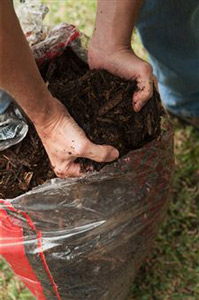 Mulch: A Lot More Than Just Another Pretty Face
Mulch: A Lot More Than Just Another Pretty Face
A lot of homeowners think of mulch as strictly cosmetic, just something to make the place look good. And its true that mulch around the base of trees and shrubs does improve property appearance.
But there's an awful lot more that mulch contributes to your landscape by making maintenance a whole lot easier, and providing other benefits that are underground and out of sight.
Managing Soil Temperatures For Better Tree Growth
Tree roots are sensitive to high summer temperatures. When the surface soil reaches 100 to 108 degrees or more (which it can during hot weather), most tree roots begin to die. Temperatures that high simply kill the roots. Unfortunately, this happens in the upper area of the soil (the top 5 to 6''), which is usually the most fertile.
A 3'' layer of mulch can reduce soil temperatures by as much as 10 degrees, maintaining a healthy growth environment for the roots, and letting them grow actively in the upper soil.
There Are Other Benefits Too
Mulched soil retains moisture much better around your trees than bare soil can. This means watering less and reducing the chance of water stress on the trees. Mulch also cuts down soil erosion or wash-out around trees, it keeps weeds down, reduces soil compaction, and can even improve soil structure as the mulch breaks down. Mulched barriers around trees also keep mowers and trimmers from causing mechanical damage to the trees.
Many Materials Available As Mulch
Mulches are either organic or inorganic. Organic choices include: bark chips and shredded bark (of which there are many kinds commercially available), wood shavings, sawdust, peat moss, cocoa hulls (a great smelling choice if you like chocolate!), straw or pine straw, rice hulls or crushed corn cobs, and yard waste like leaves, grass and twigs. Those in the yard waste group are not widely used because they don't usually improve property appearance as much as the commercially produced mulches.
Inorganic mulches include gravel (or crushed rock), a variety of sheet materials (like plastic), and several types of shredded rubber or tires. Of the commercially produced mulches, costs vary greatly depending on the area of the country, but overall, the wood and bark products are the most common and economical.
A Couple Quick Pointers On Mulching
If you mulch in the fall, wait until the first really cold snap is over. By then, most ground-burrowing rodents have settled themselves for the winter. Mulch earlier, and they may decide to move into your beds. You should also keep mulch from piling up around the trunk. Don't simply keep adding to the top of the pile each year, as this can cause rot, disease, and insect problems at the base. Apply mulch 2'' to 5'' deep after removing grass and weeds and cultivating the soil.
Extra Pointers
Mulch reduces soil temperature as much as 10 degrees enough to make a difference between supporting or killing tiny feeder roots near the surface. Mulch applied around your trees each year reduces water stress, weeds and damage to trees. Many materials work well as mulch, with wood products being the most common. Don't mulch in early fall to prevent mice and ground squirrels from nesting in beds.
So, besides helping the place put on a happy face, Dayton Landscaping suggests mulching every year for all the plain good health it delivers. If you want us to perform this service for you don't hesitate to call (937) 299-9794.
